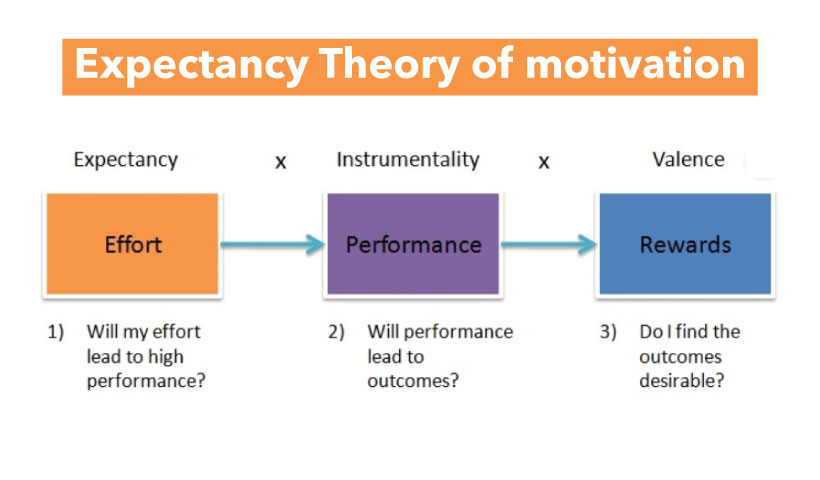Expectancy theory definition
Vroom's expectancy theory of motivation is a process theory of motivation that suggests that an individual's motivation to perform a task is determined by their belief that their effort will lead to desired outcomes, and their belief that those outcomes are valuable to them.
Expectancy theory is a useful tool for understanding and managing employee motivation. By understanding the three components of expectancy theory, managers can create rewards and incentives that are more likely to motivate employees to perform well.
The three components of expectancy theory are:
• Expectancy (E): The belief that effort will lead to performance. This is the individual's assessment of their own ability to succeed. It is influenced by factors such as their skills, knowledge, and experience, as well as the difficulty of the task.
• Instrumentality (I): The belief that performance will lead to a desired outcome. This is the individual's belief that if they perform well, they will be rewarded. The reward could be anything that the individual values, such as a promotion, a pay raise, or simply a feeling of accomplishment.
• Valence (V): The value that the individual places on the desired outcome. This is how much the individual wants or desires the reward. It is influenced by factors such as the individual's needs, goals, and values.
The three components of expectancy theory are multiplicative, meaning that they all interact with each other to determine an individual's motivation. For example, if an individual has a high expectancy but a low instrumentality, they will not be motivated to perform well. Similarly, if an individual has a high expectancy and instrumentality but a low valence, they will also not be motivated to perform well.

Importance of expectancy theory
Expectancy theory is a motivational theory that explains the importance of individuals' beliefs about the relationship between effort, performance, and rewards. It suggests that people are motivated to act in ways that they believe will lead to desirable outcomes or rewards.
Here are some key points highlighting the importance of expectancy theory:
1. Understanding Motivation: Expectancy theory provides insights into how individuals are motivated and make decisions based on their perceptions of the expected outcomes of their actions. It emphasizes that motivation is not solely determined by rewards but also by people's expectations of achieving those rewards.
2. Performance-Outcome Link: The theory focuses on the connection between effort and performance, suggesting that individuals are more likely to put in effort if they believe it will lead to better performance. This understanding helps organizations design performance management systems that align individual efforts with organizational goals.
3. Individual Differences: Expectancy theory recognizes that individuals have different expectations and values, and it highlights the importance of understanding these individual differences to motivate and manage employees effectively. Managers can use this theory to tailor rewards and create individualized incentives that are aligned with employees' expectations and desired outcomes.
4. Goal Setting: The theory emphasizes the role of goals in motivation. It suggests that setting specific, challenging goals can enhance motivation by increasing individuals' expectations of achieving desired outcomes. By setting clear goals and providing necessary support and resources, organizations can foster motivation and improve performance.
5. Performance-Reward Link: Expectancy theory highlights the importance of the perceived connection between performance and rewards. It suggests that individuals are motivated when they believe that their performance will be recognized and rewarded appropriately. Organizations can use this understanding to design reward systems that are perceived as fair and equitable, which can enhance motivation and satisfaction among employees.
6. Decision Making: Expectancy theory also offers insights into individuals' decision-making processes. People are more likely to engage in behaviors they perceive as leading to positive outcomes and rewards. By understanding employees' expectations and the factors influencing their decision-making, organizations can make informed decisions about resource allocation, task assignments, and performance evaluations.
Overall, expectancy theory is important because it provides a framework for understanding and influencing motivation in various contexts. By considering individuals' expectations and beliefs about the link between effort, performance, and rewards, organizations can design more effective motivational strategies and create a work environment that fosters higher levels of motivation, performance, and job satisfaction.
Criticism of expectancy theory
Expectancy theory is a widely accepted theory in the field of organizational behavior and motivation. However, like any other theory, it is not without its criticisms. Some of the main criticisms of expectancy theory include:
1. Oversimplification:
One of the main criticisms of expectancy theory is that it oversimplifies the complexity of human motivation. It assumes that individuals are rational decision-makers who carefully assess the probability of success and the value of outcomes. However, human motivation is influenced by various other factors such as emotions, social context, and personal values, which the theory fails to adequately address.
2. Lack of empirical support:
While expectancy theory has received some empirical support, there is also a lack of consistent evidence to fully validate its predictions. The theory relies heavily on subjective perceptions and individual beliefs, which can be difficult to measure and quantify accurately. As a result, some researchers argue that the theory lacks strong empirical support.
3. Ignoring intrinsic motivation:
Expectancy theory primarily focuses on extrinsic motivation, which is driven by external rewards such as pay raises or promotions. Critics argue that the theory neglects the importance of intrinsic motivation, which arises from internal factors such as personal satisfaction, enjoyment, and a sense of purpose. Intrinsic motivation plays a significant role in many real-life scenarios, and its exclusion limits the theory's applicability.
4. Neglecting the social context:
Expectancy theory primarily emphasizes individual motivation and largely overlooks the influence of the social context. In reality, people's motivation can be influenced by social factors such as social norms, group dynamics, and organizational culture. By ignoring the social dimension, the theory fails to provide a comprehensive understanding of motivation in real-life settings.
5. Limited applicability to complex tasks:
Expectancy theory assumes that individuals have a clear understanding of the relationship between effort, performance, and outcomes. However, this assumption may not hold true for complex tasks that involve uncertainty, interdependence, and multiple performance dimensions. In such cases, the theory's predictions may not accurately capture the complexities of motivation.
6. Overemphasis on rewards:
Expectancy theory places significant emphasis on the role of rewards in motivating individuals. Critics argue that this focus on rewards can lead to a narrow perspective on motivation, reducing it to a simple exchange of effort for tangible rewards. This overlooks the importance of other factors such as meaningful work, autonomy, and personal growth in motivating individuals.
It is worth noting that despite these criticisms, expectancy theory still provides valuable insights into motivation and has been influential in shaping research and practice in the field of organizational behavior. However, it is essential to recognize its limitations and consider alternative theories and approaches to gain a more comprehensive understanding of motivation.
Expectancy theory in the workplace
Expectancy theory is a motivational theory that suggests that people are motivated to engage in behaviors or activities when they believe that their effort will lead to improved performance and that improved performance will result in meaningful rewards or outcomes.
Expectancy theory can be used in the workplace to motivate employees in a number of ways. For example, managers can:
• Set clear and achievable goals. Employees are more likely to believe that their efforts will lead to improved performance if they have clear goals to work towards.
• Provide regular feedback. Employees need to know how they are performing in order to believe that their efforts are making a difference.
• Offer meaningful rewards. Rewards need to be something that employees value in order to motivate them to achieve their goals.
• Create a positive work environment. Employees are more likely to be motivated if they feel valued and respected in their workplace.
Expectancy theory is a complex theory, but it can be a valuable tool for managers who want to motivate their employees and improve their performance.
Here are some examples of how expectancy theory can be applied in the workplace:
• A salesperson who believes that putting in extra effort will lead to more sales and, as a result, a higher commission, is more likely to be motivated to work hard.
• A customer service representative who believes that providing excellent customer service will lead to positive feedback from customers and, as a result, a better performance review, is more likely to go the extra mile to help customers.
• A software engineer who believes that developing innovative software will lead to a promotion and, as a result, a higher salary, is more likely to be creative and take risks in their work.
Overall, expectancy theory is a useful framework for understanding how employees are motivated. By understanding the three key elements of expectancy theory, managers can create a work environment that motivates employees to achieve their goals and perform at their best.
In summary, expectancy theory suggests that employees will be motivated to exert effort when they believe that their efforts will result in good performance, performance will lead to desired outcomes, and they value those outcomes. Managers can apply this theory by ensuring clear performance expectations, providing meaningful rewards and recognition, and understanding and catering to individual preferences and values.
However, it's important to note that expectancy theory is just one of several motivational theories, and individual motivation is influenced by various factors. Organizations should consider a combination of motivational approaches and strategies to effectively engage and motivate their employees.
Expectancy theory in business
Expectancy theory focuses on how employees make decisions regarding their effort, performance, and overall job satisfaction.
According to expectancy theory, motivation is highest when all three components—expectancy, instrumentality, and valence—are strong. If any of these components are lacking, it may reduce motivation and effort. To enhance motivation and performance, businesses can consider the following strategies:
1. Clear goal setting: Clearly define performance expectations and communicate them to employees. Ensure that goals are challenging yet attainable.
2. Training and development: Provide employees with the necessary knowledge, skills, and resources to perform their tasks effectively. This enhances their confidence in their ability to achieve desired outcomes.
3. Performance feedback: Regularly provide constructive feedback on employees' performance to help them understand the link between their efforts and outcomes. Feedback can also be used to address any performance gaps or barriers.
4. Reward systems: Establish reward systems that align with employees' preferences and value systems. This could include monetary incentives, recognition programs, career advancement opportunities, or a positive work environment.
5. Employee involvement: Involve employees in decision-making processes and allow them to have a say in setting their goals and determining the rewards associated with performance. This increases their sense of ownership and motivation.
By understanding and applying expectancy theory in business settings, organizations can create a motivational environment that encourages employees to perform at their best, leading to improved individual and organizational outcomes.
Expectancy theory of motivation in education
The Expectancy Theory of Motivation can be applied to the context of education. According to this theory, individuals are motivated to act in certain ways based on their belief that their efforts will lead to desired outcomes and that those outcomes are valuable to them. In an educational setting, the Expectancy Theory suggests that students' motivation to learn and achieve academic success is influenced by three key factors: expectancy, instrumentality, and valence.
1. Expectancy: Expectancy refers to a student's belief that their efforts will result in successful performance. In other words, students need to believe that if they put in the necessary effort and engage in effective study strategies, they will be able to achieve their desired academic outcomes. If students lack confidence in their abilities or perceive a lack of alignment between effort and performance, their motivation may be negatively affected.
2. Instrumentality: Instrumentality refers to the perception that performance is linked to specific outcomes or rewards. Students must believe that their academic achievements will lead to meaningful rewards or desired outcomes, such as good grades, praise from teachers or parents, college admission, career opportunities, or personal satisfaction. If students do not see a clear connection between their academic performance and these outcomes, their motivation may be diminished.
3. Valence: Valence refers to the value or desirability that individuals place on the outcomes or rewards associated with their performance. Different students may have different preferences and priorities when it comes to the rewards they value most. For example, some students may be primarily motivated by intrinsic rewards, such as a sense of accomplishment or personal growth, while others may be more motivated by external rewards, such as grades or scholarships. The perceived value of these outcomes influences students' motivation to pursue them.
Based on the Expectancy Theory, educators can take several steps to enhance students' motivation in the classroom:
1. Enhance Expectancy: Teachers can provide clear instructions, set realistic expectations, and offer support and guidance to help students develop a sense of self-efficacy. Promoting a growth mindset and providing constructive feedback can also help students believe in their abilities to improve and succeed academically.
2. Establish Instrumentality: Teachers can establish a clear link between academic performance and desired outcomes by explaining the relevance of the subject matter, connecting it to real-world applications, and highlighting the potential benefits of learning. Providing opportunities for students to apply their knowledge in practical contexts can also reinforce the connection between effort and desired outcomes.
3. Increase Valence: Educators can tap into students' interests, passions, and personal goals to make learning more meaningful and relevant. Offering a variety of rewards or incentives that align with individual students' preferences can also enhance motivation. Additionally, creating a positive and supportive learning environment that fosters a sense of belonging and intrinsic motivation can increase the perceived value of academic achievements.
Expectancy theory of motivation examples
The Expectancy Theory of Motivation suggests that an individual's motivation to perform a particular behavior or task is influenced by their beliefs about the outcome of that behavior and the perceived value of that outcome. Here are some examples that illustrate the Expectancy Theory of Motivation:
1. Pay-for-Performance: In many organizations, employees are motivated by the expectation that their performance will be directly linked to financial rewards. For example, if an employee believes that putting in extra effort will result in a higher performance appraisal, which in turn will lead to a salary increase or bonus, they are more likely to be motivated to work harder.
2. Promotion Opportunities: Employees often work towards promotions and career advancements. In this case, the expectancy theory comes into play. If an employee believes that performing well in their current role will increase their chances of being promoted, they will be motivated to put in the effort to meet or exceed their job expectations.
3. Educational Pursuits: Students pursuing higher education may be motivated by the expectancy theory. For instance, if a student believes that studying hard and performing well on exams will lead to better job prospects and higher earning potential in the future, they are likely to be motivated to put in the necessary effort to succeed academically.
4. Entrepreneurial Success: Individuals who start their own businesses often do so with the expectation of achieving financial success and personal fulfillment. They believe that their hard work, innovative ideas, and dedication will result in the growth and profitability of their venture. This expectation of a positive outcome serves as a motivator for them to overcome challenges and persevere in their entrepreneurial journey.
5. Exercise and Fitness: People who engage in regular exercise and fitness activities may be motivated by the expectancy theory. If someone believes that consistently working out and maintaining a healthy lifestyle will result in improved physical fitness, weight loss, and overall well-being, they are more likely to stay motivated and committed to their exercise routine.
These examples demonstrate how individuals' motivation can be influenced by their expectations regarding the outcomes of their efforts. The perceived value of those outcomes plays a crucial role in determining their motivation level.








